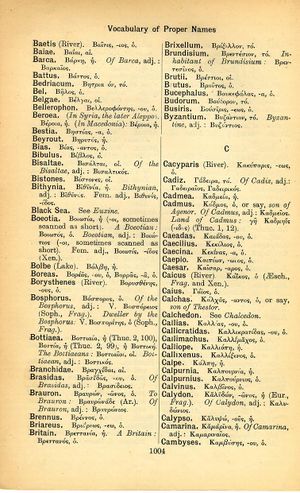Cadmus: Difference between revisions
Τὰ θνητὰ πάντα μεταβολὰς πολλὰς ἔχει → Mortalium res plurimas capiunt vices → Was sterblich ist, kennt alles viele Umschwünge
m (Text replacement - "link={{" to "link={{") |
m (Text replacement - "(|thumb)\n(\|link=)" to "$1$2") |
||
| Line 1: | Line 1: | ||
{{WoodhouseENELnames | {{WoodhouseENELnames | ||
|Text=[[File:woodhouse_1004.jpg|thumb | |Text=[[File:woodhouse_1004.jpg|thumb|link={{filepath:woodhouse_1004.jpg}}]]Κάδμος, ὁ, or say, <b class="b2">son of Agenor.</b> | ||
|link={{filepath:woodhouse_1004.jpg}}]]Κάδμος, ὁ, or say, <b class="b2">son of Agenor.</b> | |||
<b class="b2">Of Cadmus</b>, adj.: Καδμεῖος. | <b class="b2">Of Cadmus</b>, adj.: Καδμεῖος. | ||
Revision as of 16:45, 18 May 2020
English > Greek (Woodhouse)
Κάδμος, ὁ, or say, son of Agenor.
Of Cadmus, adj.: Καδμεῖος.
Land of Cadmus: γῆ Καδμηΐς (-ιδος) (Thuc. 1, 12).
Latin > English (Lewis & Short)
Cadmus: i, m., = Κάδμος.
I Son of the Phœnician king Agenor, brother of Europa, husband of Harmonia, father of Polydorus, Ino, Semele, Autonoë, and Agave; founder of the Cadmea, the citadel of the Bœotian Thebes, Cic. Tusc. 1, 12, 28; id. N. D. 3. 19, 48; Ov. M. 3, 14 sq.; id. F. 1, 490; id. P. 4, 10, 55; the inventor of alphabetic writing, Plin. 7, 56, 57, § 192 sqq. (hence letters are called Cadmi filiolae atricolores, Aus. Ep. 29; and Cadmi nigellae filiae, id. ib. 21). He and his wife. Harmonia were at last changed into serpents, Ov. M. 4, 572 sq.; Hor. A. P. 187; cf. Hyg. Fab. 6; 148; 179; 274.—Hence, Cadmi soror, i. e. Europa, Ov. P. 4, 10, 55.—
B Derivv.
1 Cadmēus, a, um, adj., = Καδμεῖος, of or pertaining to Cadmus, Cadmean: Thebae, Prop. 1, 7, 1: juventus, i. e. Thebana, Theban, Stat. Th. 8, 601: Dirce (because in the neighborhood of Thebes), Luc. 3, 175: mater, i. e. Agave, the mother of Pentheus, Sen. Oedip. 1005: cistae, i. e. of Bacchus (because Bacchus was the grandson of Cadmus by Semele), id. Herc. Oet. 595: Tyros (because Cadmus came from Phœnicia), Prop. 3 (4), 13, 7.—Also Carthaginian: gens, stirps, manus = Carthaginiensis, Sil. 1, 6; 1, 106; 17, 582.—
b Subst.: Cadmēa, ae, f. (sc. arx), the citadel of Thebes founded by Cadmus, Nep. Pelop. 1, 2; id. Epam. 10, 3.—
2 Cad-mēĭus, a, um, adj., Cadmean: genitrix, i. e. Agave, Stat. Th. 4, 565: seges, i. e. the armed men that sprang from the dragon's teeth sown by Cadmus, Val. Fl. 7, 282: heros, i. e. the Theban, Polynices, Stat. Th. 3, 366; so, Haemon, id. 8, 458 and 520.—
3 Cadmēïs, ĭdis, f. adj. (acc. Cadmeidem and Cadmeida, Neue, Formenl. 1, 211; 1, 305; voc. Cadmei, ib. 1, 293), = Καδμηΐς, of Cadmus, Cadmean: domus, Ov. M. 4, 545: arx, id. ib. 6, 217: matres, i. e. Theban women, id. ib. 9, 304.—
b Subst., a female descendant of Cadmus; so of Semele, Ov. M. 3, 287; of Ino, id. F. 6, 553.—Plur. Cadmeïdes, the daughters of Cadmus, Agave, Ino, and Autonoë, Sen. Herc. Fur. 758.—
II An historian of Miletus, said to have been the earliest prose writer, Plin. 5, 29, 31, § 112; 7, 56, 57, § 205.—
III A bloodthirsty executioner in the time of Horace, Hor. S. 1, 6, 39; Schol. Crucq.—
A mountain in Caria, Plin. 5, 29, 31, § 118.
Latin > French (Gaffiot 2016)
Cadmus,¹² ī, m. (Κάδμος),
1 fils d’Agénor, frère d’Europe, fondateur de la Cadmée : Cic. Tusc. 1, 28 ; Ov. M. 1, 15 ; F. 1, 490
2 nom d’un bourreau à Rome : Hor. S. 1, 6, 39
3 Milésien qui le premier a écrit l’histoire en prose : Plin. 5, 112
4 montagne de Phrygie : Plin. 5, 118.
Latin > German (Georges)
Cadmus, ī, m. (Κάδμος), I) Sohn des phönizischen Königs Agenor, Gemahl der Harmonia, Vater des Polydorus, der Semele, Agave, Ino u. Autonoë. Er kam, um seine von Zeus nach Kreta entführte Schwester Europa zu suchen, nach Böotien, gründete dort Cadmea, die Burg des spätern böotischen Thebens (Ov. met. 1, 15 sq.; fast. 1, 490), brachte ein Alphabet von 16 Buchstaben mit nach Griechenland (Plin. 7, 192), erfand das Schmelzen des Erzes (Plin. 7, 197. Hyg. fab. 274) u. wurde zuletzt samt seiner Gattin Harmonia in Drachen verwandelt, Ov. met. 4, 463 sqq. Hor. de art. poët. 187; vgl. Hyg. fab. 178 sq. – dah. Cadmi soror, Europa (als Weltteil), Ov. ex Pont. 4, 10, 55: Cadmi nigellae filiae od. filiolae atricolores, von den Buchstaben, Auson. ep. 4, 74 u. 7, 52. – Dav. abgel.: A) Cadmēis, idos, Akk. ida, f. (Καδμηΐς), zu Kadmus gehörig, kadmëisch, poet. = thebanisch, arx, Ov.: matres, Ov. – subst., eine Kadmëide (= Tochter des Kadmus), wie Semele u. Ino, Acc. fr. u. Ov.: u. Plur. Cadmēides, Agave, Ino u. Autonoë, Sen. poët. – B) Cadmēius, a, um (Καδμήϊος), kadmëisch, genetrix, Agave, Stat.: seges, die von Kadmus gesäten Drachenzähne, Val. Flacc.: heros, der Thebaner Polyneikes, Stat. – C) Cadmēus, a, um (Καδμειος), zu Kadmus gehörig, kadmëisch, poet. = thebanisch, Thebae, Prop.: cistae, bacchische (weil Bacchus Enkel des Kadmus von der Semele), Sen. poët.: Tyros (weil Kadmus aus Phönizien), Prop.: dah. gens, stirps, manus, karthagisch, Sil. – subst., Cadmēa, ae, f. (sc. arx), die Burg in Theben (von Kadmus gegründet), Nep. – D) Cadmogena, ae, f., von Kadmus gezeugt, Semela, *Acc. tr. 642. – II) aus Milet, Logograph u. einer der ersten Prosaisten, kurz vor den Perserkriegen, Plin. 7, 205. – III) ein grausamer Henker zur Zeit des Horaz, Hor. sat. 1, 6, 39.

